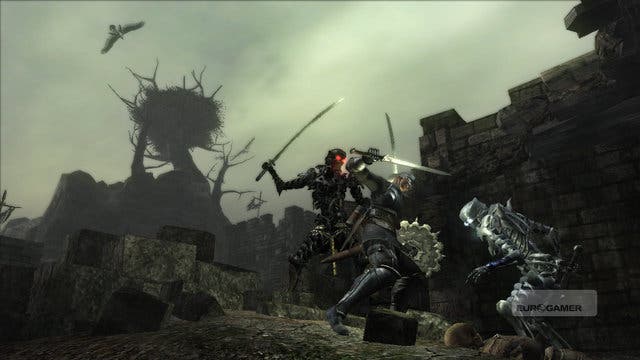For and Against: Violence in video games
Keza vs. Kristan.
As followers of the For and Against series will know, we've already addressed the issues of motion control and fanboyism. This month, we're having a look at the issue of violence in video games.
Taking part in the debate are Kristan Reed and Keza MacDonald, veteran Eurogamer contributors and, in real life, common law Mr and Mrs. So basically, read the following pages while imagining the sound of Ricicles being crunched and you can pretend you're sitting round their breakfast table.
Once you've decided whose side you're on, be sure to cast your vote in our poll. Next month: For and Against It Being Keza's Turn to Do the Washing Up (TBC).
The Case For... By Kristan Reed
I've never been a sensitive flower. Perhaps the only thing which has ever made me dive behind the sofa was the infamous infinite tunnel sequence at the end of Doctor Who, and goodness knows what that was all about. I know I'm not the only one.
Before I'd reached the tender age of 10, my older sister had inadvertently (irresponsibly?) turned me into a horror nut. She let my poor young brain devour the likes of Alien, Salem's Lot, Creep Show, The Exorcist, The Omen and An American Werewolf In London.
Some of you might recoil at the mention of those offerings, but I never flinched. They were all memorably violent and tremendously exciting. Compelling, yes, but emotionally harrowing? Not remotely.

For me, some of the most disturbing, dreadful things in life are the things you can't see. What really gets to me is the terror of a lonely bike ride down a country lane in the midst of a winter evening, or a tentative stroll in a desolate wood.
The impact of witnessing stuntman violence and pretend gore has always been softened by the knowledge that it's not real. I've long been fascinated by the construction of special effects, and have experienced annoying desires to perform frame-by-frame slow-motion analyses of hideous death scenes.
In real terms, though, seeing an actor perish in bloody agony has always had the same emotional resonance as watching Tom & Jerry flatten each other with anvils and ACME hammers. Somewhere in the background, my logic centres bellow, "It's not real, idiot," over and over.
I have a similar feeling about video games. It all began back in the early days of the ZX Spectrum and the Commodore 64. As a pre-teenager in the mid-eighties, a friend and I obsessed over a horror strategy-adventure called The Rats.
In the game, characters from the infamous James Herbert novel were put in a series of life-or-death scenarios. It was up to you to save them, in real time, from being eaten alive by giant mutant rodents.

There wasn't much point hiding in cupboards. They'd sniff you out, munch through the wood and chow down on your squishy entrails until you blacked out from the pain.
Cue screaming and the splatter of blood over the monitor. You can probably guess that the effect wasn't brilliant in 1985, but we evidently had fantastic imaginations back then.
And we absolutely loved The Rats. That palpitating tension, the triggering of the fight or flight response... These violent, disgusting, horrible video games had an emotional impact that books and movies never seemed capable of getting close to.
As a result, we devoured as many of them as we could lay our hands on. Back then, though, no-one worried about violence in video games, even though there was a fair bit of it going on.
In the years that have followed, in-game visuals have improved to such a degree that attempts to recreate graphic violence have felt like salvos in a petty and pointless arms race.

